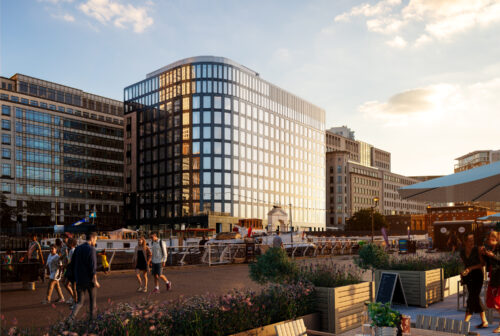Can bricks and mortar unlock bench to bedside innovation?

Image: LS Estates – Columbus Courtyard, Canary Wharf
We explore how effective placemaking can turn Britain’s life-science dreams into reality.
The government’s Industrial Strategy report identified the ‘IS-8’, eight sectors considered central to unlocking national growth: advanced manufacturing, clean energy, creative industries, defence, digital technologies, financial services, professional and business services and life sciences.
As Reeves places her bets on the IS-8, the Chancellor has singled out life sciences as a sector with exceptional potential, capable of boosting productivity while improving health outcomes across the UK.
The Life Sciences Sector Plan, announced in July, put more meat to the bone and announced over £2 billion in public investment. This included a £600 million package for health-data systems, £520 million for domestic manufacturing and streamlined regulation for clinical trials. Crucially, it also sets out ambitions to improve research infrastructure, support more start-ups and scale-ups and accelerate the adoption of innovation in the NHS.
Is placemaking the missing piece of the puzzle?
While both strategies focus heavily on investment and regulation, laboratories, research centres and the companies they house cannot thrive in isolation. Their ability to innovate is closely tied to the quality of the built environment around them. To discover breakthroughs and grow, life science businesses need well-designed and connected places where they can collaborate, attract skilled talent and integrate with local communities.
Without this, the UK’s life science potential risks being stifled and Reeves’s growth plans left out in the cold.
The foundations of the issue
High-quality lab and R&D space is scarce in parts of the UK. Knight Frank’s recent report shows available lab space in London meets only a quarter of current demand. This shortage has created a bottleneck in supply, driving up rents and making it harder for both early-stage start-ups and established firms to secure space.
While cost and space are major factors, effective placemaking – from smart planning and transport links to amenities, sustainability standards and community engagement – can be just as important in ensuring investment sticks and research can flourish.
Creating the right conditions for innovation
We look at three examples of how the built environment is helping to create innovation-ready spaces…
- Listening and adapting to community needs – The £1 billion London Cancer Hub from Aviva Capital Partners and Socius aims to become a global centre for cancer research in south London, described by The Times as a “Silicon Valley for oncology”. By clustering hospitals, cancer charities, biotech firms and start-ups, the 12-acre development will accelerate the journey from research to treatment.
Meeting Place has supported the proposals through PR and community engagement, ensuring local voices shape the vision. Feedback from more than 4,500 residents revealed strong demand for new amenities and recreational spaces. This led to plans for meanwhile-use padel courts as well as cafés, restaurants, a walking track, a crèche and affordable housing for staff to make the site an attractive and integrated part of the community. - Retrofitting and repurposing – Converting existing buildings into lab-ready spaces can help address the UK’s supply constraints. LS Estates is doing just that at Columbus Courtyard, Canary Wharf, transforming a former office block into flexible life science facilities.
This approach reduces embodied carbon, shortens delivery times and meets the sector’s demand for adaptable space. Alongside PR support, Meeting Place has developed a social value programme connecting LS Estates with local organisations and the Tower Hamlets community to ensure benefits extend well beyond the site boundary. - Ample amenities and streamlined planning – Milton Park, Oxfordshire, one of the UK’s largest science, business and technology communities, is unlocking growth through an innovative approach to planning. Its unique Local Development Order allows certain projects to gain planning consent in just ten days, allowing occupiers to act quickly on growth and investment opportunities. The park also offers flexible spaces such as the Bee House co-working hub, shared laboratories and a wealth of amenities to help tenants attract and retain top talent.
Recently, Meeting Place hosted a tour with DESNZ for the Government’s Chief Scientific Adviser Professor Paul Monks, showcasing innovation clusters such as Milton Park can deliver on both green growth and life sciences ambitions.
Whether by responding to community needs, retrofitting buildings or rethinking planning frameworks, the built environment can be a powerful enabler for the Government’s Life Sciences Sector Plan.
If we want laboratories to turn discoveries into products and products into better health outcomes, we need to focus on their physical setting. What’s needed now is the ambition and imagination to design environments where the UK’s innovation community can truly thrive.
